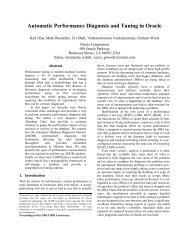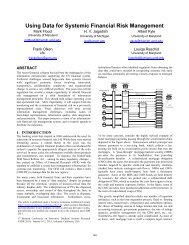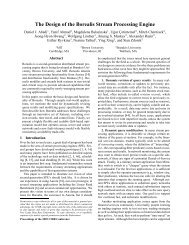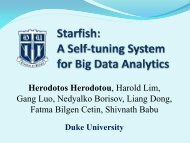SwissBox: An Architecture for Data Processing Appliances
SwissBox: An Architecture for Data Processing Appliances
SwissBox: An Architecture for Data Processing Appliances
Create successful ePaper yourself
Turn your PDF publications into a flip-book with our unique Google optimized e-Paper software.
ing highly optimized query plans. For instance, operators such as<br />
sort, group by, and aggregation can be easily placed on cores next<br />
to Crescando cores. The result is that there is no traffic over the<br />
network as, in many cases, the entire query can be pushed down to<br />
the storage layer. This design mirrors somewhat that of TwinFin<br />
in that it blurs the separation between data processing and storage<br />
nodes. Unlike TwinFin, however, we can eliminate the traffic over<br />
the network entirely <strong>for</strong> some queries and we can choose to place<br />
the operators in the data processing nodes instead <strong>for</strong> scalability<br />
and elasticity purposes.<br />
The advantage of the data processing layer approach is that we<br />
can maintain the predictability of the system by ensuring the execution<br />
of a part of a query that runs on these nodes has a well<br />
defined upper bound. The overall cost of a query would then be<br />
the time to get the data from the storage layer (which is accurately<br />
defined thanks to the Crescando approach), the transmission overhead<br />
of the network if any, and the processing overhead of the high<br />
level SQL operators in the data processing nodes. We believe that<br />
the unique architecture of <strong>SwissBox</strong> allows to place tight bounds<br />
on these overheads and to capture these bounds with very few parameters.<br />
This opens up the possibility of tools <strong>for</strong> automatic configuration<br />
of all layers of <strong>SwissBox</strong> given a set of response time<br />
requirements. Note that such tools will make heavy use of the open<br />
interface of Barrelfish, the well defined tuning parameters of Crescando,<br />
and the elasticity of the data processing layer, with the hardware<br />
acceleration and the possibility of pushing down operators<br />
close to the storage layer providing additional leverage to address<br />
the problem.<br />
8. CONCLUSIONS<br />
<strong>SwissBox</strong> is intended both as a data appliance to be deployed in<br />
real settings and as a vehicle <strong>for</strong> research to enable the complete<br />
redesign of the software stack.<br />
As an appliance, <strong>SwissBox</strong> has a number of unique features that<br />
make it very suitable to the use cases described earlier as well as<br />
in a wide range of other environments. In <strong>SwissBox</strong>, there is no<br />
locking or read-write contention at the storage layer, allowing us<br />
to support very high update rates without impacting the read rates.<br />
Moreover, all layers of the system but specially the storage manager<br />
–which is traditionally the main problem in this regard– provide<br />
predictable per<strong>for</strong>mance <strong>for</strong> both reads and writes. This allows us<br />
to build systems that by design can meet tight response time constraints.<br />
When compared to key-value stores like Cassandra [1], Swiss-<br />
Box provides full data consistency, elasticity, and the ability to per<strong>for</strong>m<br />
complex SQL queries, thereby establishing a completely new<br />
point in the design space. When compared to existing appliances,<br />
<strong>SwissBox</strong>’s multi-query optimization strategies at all levels and the<br />
organization of work into independent units mapped to cores provide<br />
a degree of flexibility and scalability that cannot be achieved<br />
with disk based systems. In <strong>SwissBox</strong> we can benefit from many of<br />
the same hardware optimizations used in existing appliances (e.g.,<br />
SSD storage, FPGA processing) but we can also exploit many other<br />
cross-layer optimizations that are not possible in today’s appliances<br />
thanks to the use of Barrelfish as the underlying operating system.<br />
As a research plat<strong>for</strong>m, <strong>SwissBox</strong> gives us the opportunity to<br />
completely redesign the data processing stack from the ground up,<br />
exploring at the same time how to best take advantage of new developments<br />
in hardware. This is a rather urgent matter given the<br />
pace at which key elements of the data processing infrastructure are<br />
evolving. That <strong>SwissBox</strong> is an appliance makes it possible to apply<br />
cross-layer optimizations within a single box, thereby opening<br />
up the possibility of taking these cross-layers optimizations much<br />
further than it has been possible in distributed plat<strong>for</strong>ms. At the<br />
same time, it will allow us to rethink the interfaces and role of the<br />
different layers of a data processing system in terms of meeting<br />
new requirements like predictable per<strong>for</strong>mance or elasticity. Our<br />
intention is to make SWissBox open source -even the hardware<br />
architecture- to provide an open plat<strong>for</strong>m <strong>for</strong> experimentation and<br />
education where new data processing techniques can be tested and<br />
compared free from the limitations and legacy constraints of existing<br />
database engines.<br />
9. REFERENCES<br />
[1] http://cassandra.apache.org/.<br />
[2] A. Baumann, P. Barham, P.-É. Dagand, T. L. Harris,<br />
R. Isaacs, S. Peter, T. Roscoe, A. Schüpbach, and<br />
A. Singhania. The multikernel: a new OS architecture <strong>for</strong><br />
scalable multicore systems. In SOSP, pages 29–44, 2009.<br />
[3] K. Birman. A History of the Virtual Synchrony Model.<br />
Technical report, Cornell University, 2009.<br />
http://www.cs.cornell.edu/ken/History.pdf.<br />
[4] D. J. DeWitt, S. Ghandeharizadeh, D. A. Schneider,<br />
A. Bricker, H.-I. Hsiao, and R. Rasmussen. The Gamma<br />
<strong>Data</strong>base Machine Project. IEEE Trans. Knowl. <strong>Data</strong> Eng.,<br />
2(1):44–62, 1990.<br />
[5] D. R. Engler, M. F. Kaashoek, and J. O’Toole, Jr. Exokernel:<br />
<strong>An</strong> operating system architecture <strong>for</strong> application-level<br />
resource management. In Proc. SOSP, pages 251–266,<br />
December 1995.<br />
[6] M. J. Franklin, S. R. Jeffery, S. Krishnamurthy, F. Reiss,<br />
S. Rizvi, E. W. 0002, O. Cooper, A. Edakkunni, and<br />
W. Hong. Design considerations <strong>for</strong> high fan-in systems: The<br />
HiFi approach. In CIDR, pages 290–304, 2005.<br />
[7] P. W. Frey and G. Alonso. Minimizing the hidden cost of<br />
RDMA. In ICDCS, pages 553–560, 2009.<br />
[8] P. W. Frey, R. Goncalves, M. L. Kersten, and J. Teubner. A<br />
spinning join that does not get dizzy. In ICDCS, pages<br />
283–292, 2010.<br />
[9] J. Gray. Notes on database operating systems. In Bayer et.<br />
al., editor, Operating Systems, an Advanced Course,<br />
number 60 in Lecture Notes in Computer Science, pages<br />
393–481. Springer-Verlag, 1978.<br />
[10] J. Howard and et al. A 48-core IA-32 message-passing<br />
processor with DVFS in 45nm CMOS. In International<br />
Solid-State Circuits Conference, pages 108–109, Feb. 2010.<br />
[11] R. R. Kompella, A. Greenberg, J. Rex<strong>for</strong>d, A. C. Snoeren,<br />
and J. Yates. Cross-layer visibility as a service. In In Proc. IV<br />
HotNets Workshop, 2005.<br />
[12] L. Lamport. Using Time Instead of Timeout <strong>for</strong><br />
Fault-Tolerant Distributed Systems. ACM Transactions on<br />
Programming Languages and Systems, 6(2), 1984.<br />
[13] R. Müller, J. Teubner, and G. Alonso. Streams on Wires - A<br />
Query Compiler <strong>for</strong> FPGAs. PVLDB, 2(1):229–240, 2009.<br />
[14] OpenFlow Consortium. Openflow. www.openflow.org,<br />
September 2010.<br />
[15] F. Schneider. Implementing Fault-Tolerant Services Using<br />
the State Machine Approach: A Tutorial. ACM Computing<br />
Surveys, 22(299), 1990.<br />
[16] P. Unterbrunner, G. Giannikis, G. Alonso, D. Fauser, and<br />
D. Kossmann. Predictable Per<strong>for</strong>mance <strong>for</strong> Unpredictable<br />
Workloads. PVLDB, 2(1):706–717, 2009.<br />
[17] L. Woods, J. Teubner, and G. Alonso. Complex event<br />
detection at wire speed with FPGAs. PVLDB, 3(1), 2010.<br />
37








